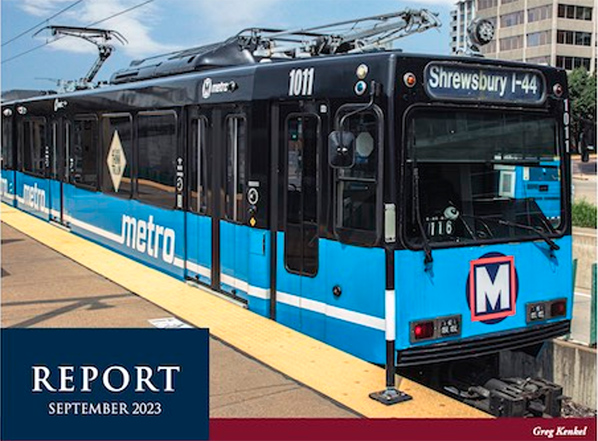
St. Louis has more miles of light rail than any other Midwestern urban area, yet fewer people rode St. Louis transit in 2019 than in 1991, before the region opened its first mile of light rail. According to a new report from the Show-Me Institute, this is because Metro, the region’s transit agency, has planned its transit system for the 1910s, not the 2020s.
That means that Metro has built a system that assumes that most people work downtown, live in dense residential neighborhoods close to light-rail stops, and don’t have access to automobiles. None of those conditions have been true for at least 50 years, and Metro’s system is especially unsuited to the post-pandemic world.
Click image to download a 4.3-MB PDF of this report.
Metro doesn’t even serve downtown all that well. Before the pandemic, only about 10 percent of downtown St. Louis workers commuted by transit. But this was much better than in the rest of the region, where less than 3 percent of workers commuted by transit.
Now Metro wants to make the system even worse by building a new, street-running north-south light-rail line. The existing east-west light-rail lines all operate in their own exclusive rights of way, which has the virtue of making them somewhat safer and faster than most other light-rail systems in the country (but still not fast enough to attract more new riders than the system’s loss of bus riders). The proposed street-running light rail would be no faster than buses and would be prone to accidents that will kill and injure far more people.
As an alternative, the Show-Me Institute report, which I wrote, proposes a network of non-stop buses to major economic centers in the St. Louis region. This is an improved version of the polycentric proposal I made for Portland, which was published recently by the Cascade Policy Institute. The Portland plan designated nine transit centers, each of which would have non-stop buses to every other transit center plus local buses radiating away from each of the hubs.
Read the rest of this piece at The Antiplanner.
Randal O'Toole, the Antiplanner, is a policy analyst with nearly 50 years of experience reviewing transportation and land-use plans and the author of The Best-Laid Plans: How Government Planning Harms Your Quality of Life, Your Pocketbook, and Your Future.
Photo: Brian Holsclaw via Flickr under CC 2.0 License.














urban musts
But every self-respecting city needs a light rail line to its downtown stadium and bars!